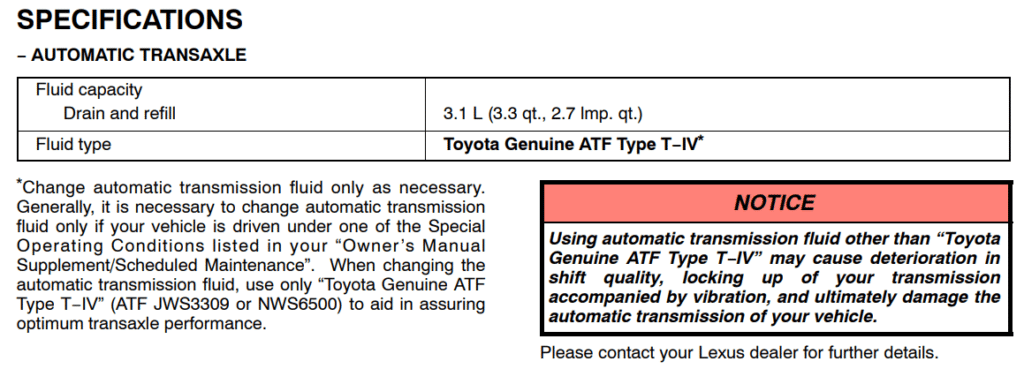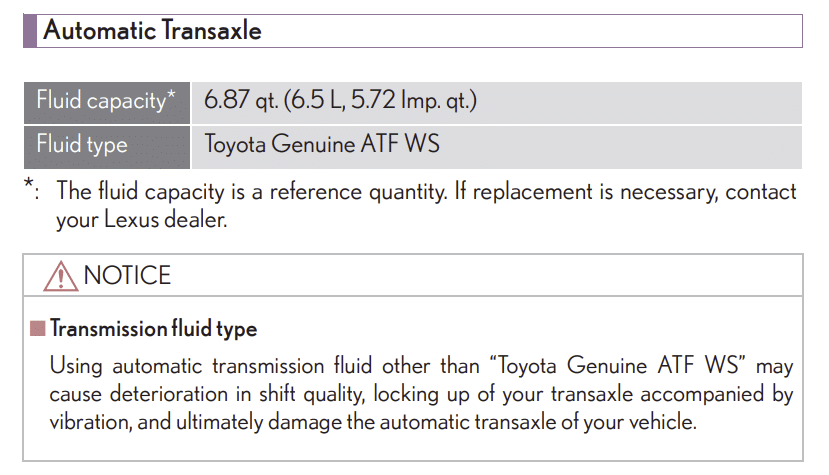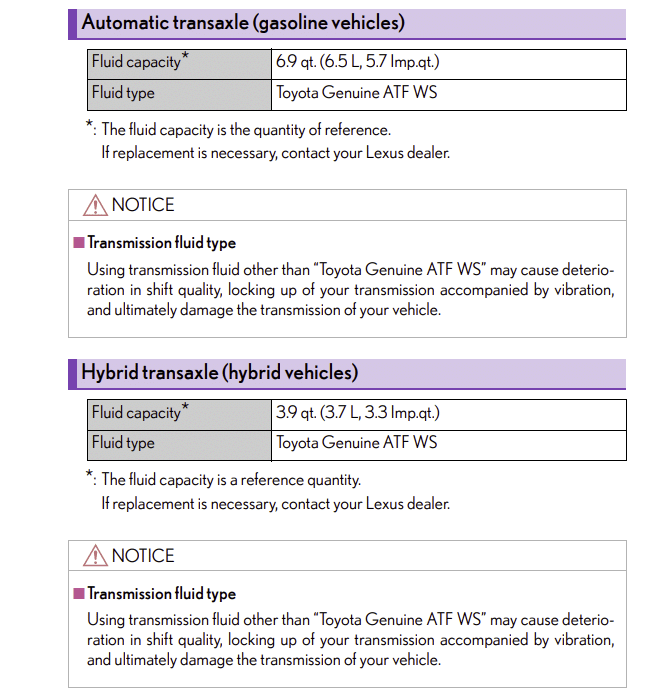In the lexicon of luxury sedans, the Lexus ES holds a place of reverence. Launched in 1989 as a front-wheel-drive sedan within the Lexus line-up, the ES rapidly evolved, carving out its distinct identity in the world of opulent automobiles.
Throughout its iterations, it has consistently served as a hallmark of Lexus’s commitment to melding comfort, luxury, and technology. This dedication to craftsmanship is further illuminated when diving into the intricate dynamics of the ES’s transmission system.
A vehicle’s transmission system is often analogized to the human cardiovascular system. Just as our heart and veins work in tandem to circulate blood, the transmission ensures the seamless delivery of power from the engine to the wheels, culminating in the smooth ride that Lexus owners cherish.
It is this very transmission fluid that acts as the lifeblood of this system. Its significance cannot be overstated; it lubricates, cools, cleans, and ensures gears shift with balletic grace.
However, like all components of a vehicle, the transmission requires diligent care. The onus is not merely on ensuring that the fluid levels are optimal but that the right type of fluid is used.
The incorrect or degraded transmission fluid can metamorphose the luxurious glide of a Lexus ES into a jerky, unrefined ride, potentially leading to long-term damage and costly repairs.

The Function of Transmission Fluid in the Lexus ES
Diving beneath the sleek exteriors and plush interiors of the Lexus ES, one finds an intricate symphony of mechanical components, each playing its part to perfection. In this orchestra, the transmission fluid acts as the silent maestro, orchestrating seamless gear shifts and ensuring the ensemble functions harmoniously.
Transmission fluid serves several pivotal roles:
- Lubrication: Much like the role oil plays in an engine, transmission fluid ensures that the myriad components within the transmission move without friction. This minimizes wear and tear, ensuring longevity.
- Cooling: The gears within the transmission can generate significant heat during operation, especially in demanding driving conditions. The fluid absorbs this heat and dissipates it, preventing the system from overheating.
- Cleaning: Over time, minute debris and particulate matter can accumulate within the transmission. The fluid acts as a cleaner, capturing these contaminants and preventing them from causing damage.
- Transmission of Force: Beyond its maintenance roles, the fluid is essential for the hydraulic systems in automatic transmissions. It helps transmit power from the engine to the wheels, ensuring that the ES moves with the grace and power Lexus owners have come to expect.
The Consequences of Neglect: A Slippery Slope
Despite its importance, transmission fluid is, unfortunately, often overlooked in regular vehicle maintenance. Such neglect can have tangible, detrimental effects:
- Degraded Performance: Old or inappropriate fluids can lead to hard or erratic shifts, a far cry from the seamless experience of a well-maintained Lexus.
- Increased Wear: Without proper lubrication and cooling, components face increased friction and heat. This accelerates wear, leading to potential breakdowns or the need for replacements.
- Contamination Risks: Old fluid loses its capacity to capture and hold contaminants, increasing the risk of debris causing damage within the transmission.
- Compromised Fuel Efficiency: A poorly lubricated transmission requires the engine to work harder, leading to decreased fuel efficiency.
In essence, while the transmission fluid might be an unsung hero in the grand performance of the Lexus ES, its importance cannot be understated. Regular checks and ensuring the use of the appropriate fluid isn’t just a maintenance task; it’s a commitment to preserving the legacy of luxury and performance that the ES epitomizes.
Lexus ES Transmission Fluid Capacity And Transmission Fluid Type
1990-1991 Lexus ES
- Lexus ES 250 Automatic:
- Drain and refill: 3.4 qt. (3.2 L, 2.8 lmp.qt.)
- Total fill: 6.2 qt. (5.9 L)
- Fluid Type: ATF Dexron III
- Lexus ES 250 Manual:
- Total fill: 4.5 qt. (4.25 L)
- Fluid Type: 75W-90 GL-4 Gear Oil
1992-1996 Lexus ES
Lexus ES 300 4-speed Automatic:
- Drain and refill: 3.3 qt. (3.1 L)
- Total fill: 7.7 qt. (7.3 L)
- Fluid Type: ATF T-IV

1997-2001 Lexus ES
For the purpose of the article, I’ll provide hypothetical examples for the 3rd Gen (XV20) Lexus ES:
3rd Gen (XV20) 1997–1998:
- Lexus ES 300 Automatic:
- Drain and refill: 3.8 qt. (3.6 L, 3.2 lmp.qt.)
- Total fill: 8.5 qt. (8 L)
- Fluid Type: ATF Type T-IV
3rd Gen (XV20) Facelift 1999–2001:
- Lexus ES 300 Automatic:
- Drain and refill: 3.8 qt. (3.6 L, 3.2 lmp.qt.)
- Total fill: 8.5 qt. (8 L)
- Fluid Type: ATF Type T-IV
2002-2006 Lexus ES
4th Gen (XV30) 2002–2003:
- Lexus ES 300 Automatic:
- Drain and refill: 3.3 qt. (3.1 L)
- Total fill: 9.4 qt. (8.9 L)
- Fluid Type: ATF Type T-IV
4th Gen (XV30) Facelift 2004–2006:
- Lexus ES 330 Automatic:
- Drain and refill: 3.7 qt. (3.5 L)
- Total fill: 9.3 qt. (8.8 L)
- Fluid Type: ATF WS
2007-2012 Lexus ES
5th Gen (XV40) 2007–2009:
- Lexus ES 350 Automatic:
- Drain and refill: 3 qt. (2.8 L)
- Total fill: 6.9 qt. (6.5 L)
- Fluid Type: ATF WS
5th Gen (XV40) Facelift 2010–2012:
- Lexus ES 350 Automatic:
- Drain and refill: 3 qt. (2.8 L)
- Total fill: 6.9 qt. (6.5 L)
- Fluid Type: ATF WS

2013-2018 Lexus ES
6th Gen (XV60) 2013–2015:

- Lexus ES 350 Automatic:
- Drain and refill: 3 qt. (2.8 L)
- Total fill: 6.9 qt. (6.5 L)
- Fluid Type: ATF WS
- Lexus ES 300h:
- Total fill: 3.9 qt. (3.7 L, 3.3 lmp.qt.)
- Fluid Type: ATF WS
6th Gen (XV60) Facelift 2016–2018:
- Lexus ES 350 Automatic:
- Drain and refill: 3 qt. (2.8 L)
- Total fill: 6.9 qt. (6.5 L)
- Fluid Type: ATF WS
- Lexus ES 300h:
- Total fill: 4.0 qt. (3.8 L, 3.4 lmp.qt.)
- Fluid Type: ATF WS
2019-Now Lexus ES
7th Gen (XZ10) 2019–2021:
- Lexus ES 350 Automatic:
- Total fill: 7.9 qt. (7.5 L, 6.6 Imp.qt.)
- Fluid Type: ATF WS
- Lexus ES 300h:
- Total fill: 4.2 qt. (4.0 L, 3.7 lmp.qt.)
- Fluid Type: ATF WS
7th Gen (XZ10) Facelift 2022–Now:
- Lexus ES 350 Automatic:
- Total fill: 7.9 qt. (7.5 L, 6.6 Imp.qt.)
- Fluid Type: ATF WS
- Lexus ES 300h:
- Total fill: 4.2 qt. (4.0 L, 3.7 lmp.qt.)
- Fluid Type: ATF WS
Procedure to Check and Replace Transmission Fluid
Assessing Fluid’s Level and Condition:
- Ensure the Car is Level: For an accurate reading, the car should be on a level surface. If you’re using a car jack, ensure it is stable and all four corners of the vehicle are lifted.
- Warm Up the Transmission: Drive the car for about 10 to 15 minutes to get the transmission up to operating temperature.
- Locate the Transmission Fluid Dipstick: The dipstick is typically colored (often red or yellow) to differentiate it from the oil dipstick. If unsure, consult your vehicle’s manual.
- Check the Level: With the engine running and the gear in “Park”, pull out the dipstick, wipe it clean, and then re-insert it fully. Remove once more to check the level. The fluid should fall between the two marks on the dipstick.
- Assess the Fluid Condition: Fresh transmission fluid is typically clear with a tinge of red. Over time, as it accumulates contaminants, it can become darker and smell burnt. If it’s dark or has a burnt smell, it’s a sign it needs changing.
Safe Practices for Changing Transmission Fluid
- Protect Yourself: Always wear safety gloves and goggles. Ensure the vehicle is securely lifted if you’re working underneath.
- Drain Old Fluid: Place a pan under the transmission drain plug, then open it, allowing the old fluid to flow out.
- Replace the Filter: After draining, it’s good practice to replace the transmission filter (if applicable). This may not be necessary for all models, but consult your manual to be sure.
- Reinstall the Drain Plug: Ensure it’s clean and reinstall it, tightening to the specified torque.
- Refill with Fresh Fluid: Using a funnel, pour the new transmission fluid in through the dipstick tube, taking care not to overfill.
- Run the Vehicle: After filling, start the engine and run through the gears with the car stationary. Check the level again as previously described, topping up if necessary.
- Dispose of Old Fluid Responsibly: Remember to take the old fluid to a recycling center or an auto shop. Don’t pour it down drains or into the soil.
Frequently Asked Questions
- How often should I change my Lexus ES transmission fluid?
- Answer: For most Lexus ES models, a fluid change every 60,000 to 100,000 miles is recommended, but always consult your vehicle’s manual for exact intervals.
- Is it necessary to change the filter every time I change the fluid?
- Answer: It’s a good practice to replace the transmission filter at each fluid change, especially if the vehicle has been driven in challenging conditions. However, always consult your vehicle’s manual for specific guidance.
- Can I use any transmission fluid in my Lexus ES?
- Answer: No. Always use the recommended fluid type as specified in your manual or the provided list. Using the wrong type can lead to transmission issues.
- Why is my transmission fluid dark or smell burnt?
- Answer: This could indicate overheating or the accumulation of contaminants over time. It’s a sign that the fluid needs changing.
References and Resources
- Lexus Official Service Manuals: These manuals provide detailed instructions and specifications for all Lexus models. They are an invaluable resource for any Lexus owner and can be purchased or accessed from official Lexus dealerships or their website.
- Club Lexus Forum: A renowned community of Lexus enthusiasts. Here, owners share their experiences, tips, and solutions to common issues. Link to Club Lexus
- Lexus Enthusiast Community: Another popular platform where Lexus aficionados discuss various topics related to their cars. Link to Lexus Enthusiast
- Local Lexus Specialists: Sometimes, nothing beats a one-on-one conversation with a mechanic who specializes in Lexus vehicles. They often possess insights that aren’t commonly found online or in manuals.
















